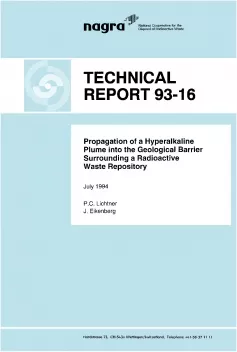
Technical Report NTB 93-16
Propagation of a Hyperalkaline Plume into the Geological Barrier Surrounding a Radioactive Waste Repository
A probable consequence of siting a cement-based low- and intermediate-level radioactive waste repository in a marl host rock is the release of a hyperalkaline plume with initial pH values as high as 13 or greater, resulting in aggressive alteration of the surrounding host rock. Thermodynamic stability relations indicate that various rock-forming silicate minerals are unstable in strongly alkaline solutions, and therefore significant alteration of the physical and chemical properties of the host rock is likely. Because of the low silica concentration characteristic of Portland cement pore fluid, a silicate-bearing host rock will dissolve on initial contact with the hyperalkaline plume. The duration of the plume could be ten thousands of years or more, depending on the amount of cement in the repository. A coupled geochemical transport model (MPATH) which includes chemical reaction kinetics is used to evaluate the alteration of Swiss argillaceous sediments in a high-pH environment and to predict the spatial propagation of the hyperalkaline plume with time. The calculations predict dissolution of quartz, clay minerals and chlorite, and precipitation of zeolite minerals such as analcime and natrolite as well as the feldspars K-feldspar and albite. In addition, Portland cement-hydrates such as calcium silicate and aluminate hydrates, ettringite and friedel-salt are also predicted to form, depending on the composition of the inlet fluid and the host rock. The dissolution of clay minerals reduces the pH of the hyperalkaline plume to levels between approximately 8 and 10, depending on the composition of the inlet fluid and the host rock. For pure advective transport through a porous medium, neglecting changes in porosity and permeability, the migration velocity of the high-pH front is calculated to be approximately one to two orders of magnitude less than that of the infiltrating groundwater. However, due to precipitation of secondary phases, in the present model concept a rapid decrease in porosity of the marl occurs several meters from the repository. At the interface between the marl host rock and cement the porosity increases as a consequence of the low silica concentration of the cement pore fluid.
